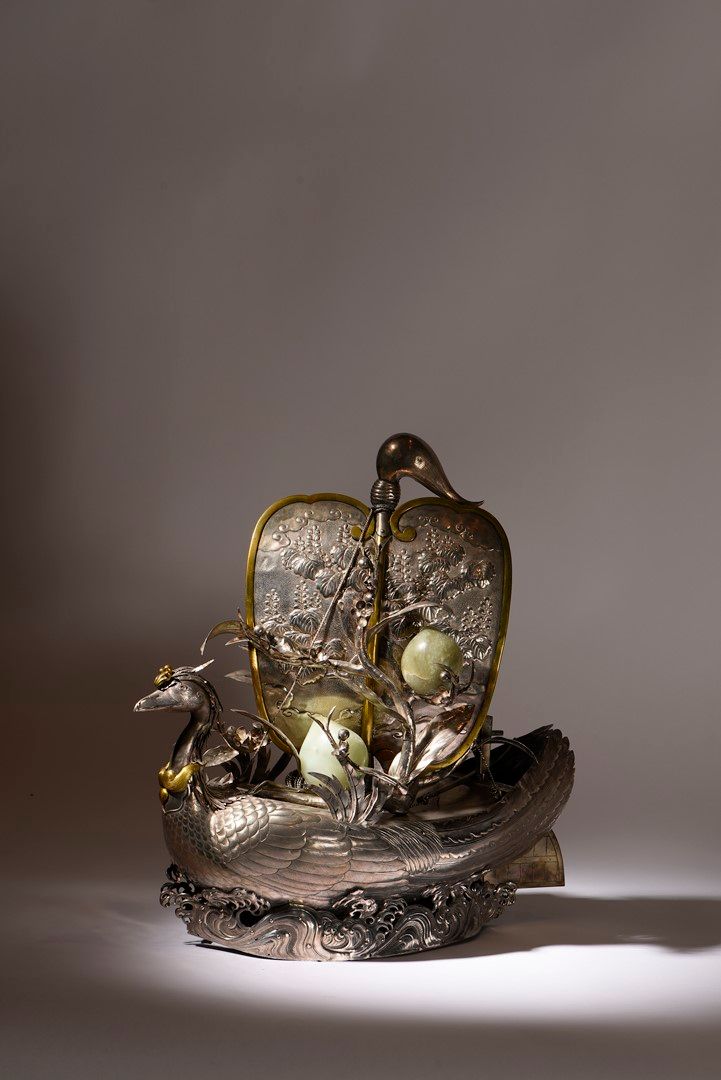Description
Rare and important representation of a boat in the shape of a phoenix. Japan, Meiji period ca 1868 / 1893. Silver and possibly other alloys partially gilded, nephrite. 40 x 44 cm. Weight 2 259 grams. Dutch hallmark with crowned "V", associated with foreign-made gold and silver creations which was in use from 1814 to 1893. Lacquer stand: 31 x 43 x 34 cm. The body of a hõõ (shape of a phoenix) constitutes the hull of the boat which sails on the moving waves. The sail is shaped like a traditional fan, and on either side of the mast stands a peach tree supporting nephrite (jade) fruits. Beyond its dimensions, the extreme quality of its realization and the preciousness of the materials used, this rare object is to be compared with the boat of the seven gods of fortune, the Takarabune, traditionally loaded with treasures. Associated with New Year's celebrations, representations of this mythical vessel are supposed to bring to those who receive them the promise of a year under the best auspices. Takarabune representations usually show the pontoon supporting images of gods or simply various symbolic treasures. Here, the fan-shaped sail is adorned with a paulownia, a tree associated with happiness and prosperity, but above all a sacred tree serving as shelter for the hõõ /phenix. Nephrite (jade) longevity peaches are also important auspicious signs. The fan and the peach of longevity are especially attributes specific to two of the gods of fortune, Fukurokuju, god of wealth, longevity, virility and wisdom, and Jurõjin / Gama, god of longevity. If the Meiji period is characterized by an extreme development of precious metal craftsmanship, the size and quality of this bird ship's creations probably makes it unique and classifies it among the major works. It is very likely that these objects were intended as prestigious gifts. A small low table of about the same period in black lacquer with silver reinforcements engraved with vegetal motifs, decorated in hiramaki-e with motifs of cranes above the waves serves as a display stand. (Small accidents and visible chips in the lacquer). Provenance :- French collection. Published / Reproduced : Marika Keblusek : " Japansch Magazijn, - Japan kunst en cultuur in de 19de-eeuws " n° 74 page 87. (Year of publication not indicated)
18
Rare and important representation of a boat in the shape of a phoenix. Japan, Meiji period ca 1868 / 1893. Silver and possibly other alloys partially gilded, nephrite. 40 x 44 cm. Weight 2 259 grams. Dutch hallmark with crowned "V", associated with foreign-made gold and silver creations which was in use from 1814 to 1893. Lacquer stand: 31 x 43 x 34 cm. The body of a hõõ (shape of a phoenix) constitutes the hull of the boat which sails on the moving waves. The sail is shaped like a traditional fan, and on either side of the mast stands a peach tree supporting nephrite (jade) fruits. Beyond its dimensions, the extreme quality of its realization and the preciousness of the materials used, this rare object is to be compared with the boat of the seven gods of fortune, the Takarabune, traditionally loaded with treasures. Associated with New Year's celebrations, representations of this mythical vessel are supposed to bring to those who receive them the promise of a year under the best auspices. Takarabune representations usually show the pontoon supporting images of gods or simply various symbolic treasures. Here, the fan-shaped sail is adorned with a paulownia, a tree associated with happiness and prosperity, but above all a sacred tree serving as shelter for the hõõ /phenix. Nephrite (jade) longevity peaches are also important auspicious signs. The fan and the peach of longevity are especially attributes specific to two of the gods of fortune, Fukurokuju, god of wealth, longevity, virility and wisdom, and Jurõjin / Gama, god of longevity. If the Meiji period is characterized by an extreme development of precious metal craftsmanship, the size and quality of this bird ship's creations probably makes it unique and classifies it among the major works. It is very likely that these objects were intended as prestigious gifts. A small low table of about the same period in black lacquer with silver reinforcements engraved with vegetal motifs, decorated in hiramaki-e with motifs of cranes above the waves serves as a display stand. (Small accidents and visible chips in the lacquer). Provenance :- French collection. Published / Reproduced : Marika Keblusek : " Japansch Magazijn, - Japan kunst en cultuur in de 19de-eeuws " n° 74 page 87. (Year of publication not indicated)
